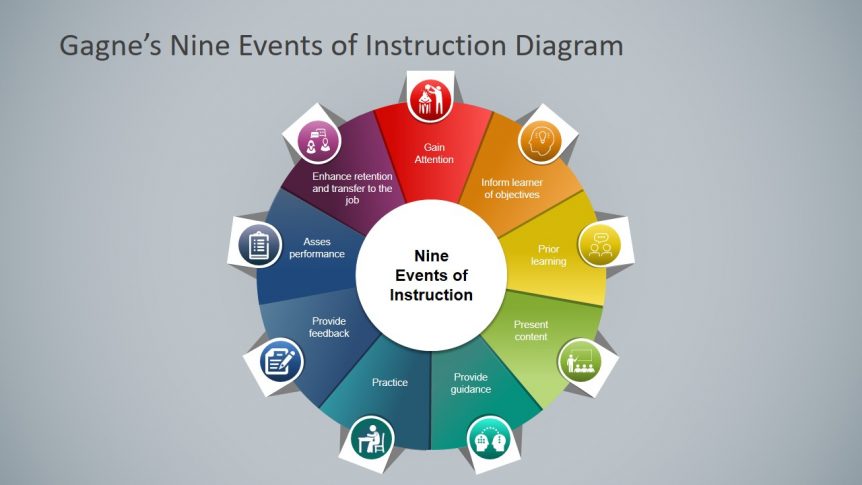In the latest in our series on instructional design models, we are going to look at Gagne’s theory of instruction, how it fits with e-learning training strategies, and how it can be applied in your organisation.
Gagne’s model of instructional design was developed by the American educational psychologist Robert Gagne. The model says there are nine different events of instruction based on the mental conditions that adults need to optimise the learning experience.
Not all of the events will be achieved through e-learning alone, but the framework provided by Gagne’s instructional design model provides a solid structure for developing e-learning courses. In fact, it is one of the most widely used instructional design models because it is so effective.
The nine steps in the Gagne instructional design model are:
- Gain attention
- Communicate objectives
- Stimulate recall
- Present the content
- Provide guidance
- Elicit performance
- Provide feedback
- Assess performance
- Improve retention
Gagne’s Nine Events of Instruction
Let’s look at each of the nine events of instruction in the Gagne model in more detail:
Gain Attention
The first step is to get the attention of learners. The aim is to encourage engagement and get an emotional response from the learner to eliminate the influence of distractions and get them focused on the topics of the course.
This can begin before the learner starts the course through promotional and informative communications. You can also present thought-provoking stories or ask challenging questions at the start of the e-learning course to get attention and achieve this first step of Gagne’s instructional design model.
Communicate Objectives
The next step is to inform learners of the objectives of the course. This includes the company’s objectives, but it is more important to explain to the learner what is in it for them. Part of this step also involves outlining the criteria for measuring progress and success.
Again, this is one of the steps in the process that can be started when you are communicating with learners, before being reinforced in the content of the e-learning course.
Stimulate Recall
You then create a foundation for the content of the course by prompting the learner to recall information and skills they already know. Getting them to draw on their past experiences and knowledge helps them to more easily frame the new information they are about to receive. It also makes the new content more relatable.
Present the Content
This part of Gagne’s instructional design model is where you present the content in the e-learning course, using various tools and strategies to ensure the content is engaging, informative, and interesting. It is also beneficial to use strategies to help the learner understand and then retain the knowledge. For example, you could use a micro-learning training strategy, where the information is presented to learners in small and easy-to-consume chunks.
Provide Guidance
This step involves giving the learner examples and other forms of content that further reinforces the information and makes it as relevant to the learner as possible. When Gagne’s nine steps were being developed, this step involved providing case studies and discussion questions. In an e-learning context, scenarios are the ideal tool. You can also use social learning elements to provoke discussions between learners.
Elicit Performance
In this step, you ask the learner to demonstrate how much of the content they understand and can remember. As with the previous step, scenarios can help with this part of the process. You can also use quizzes or even gamified elements – anything that involves the learner recalling information or using new skills.
Provide Feedback
It is important that learners have a clear picture of how well they have grasped the information in the e-learning course. This step in the process gives them that information. There are many ways to achieve this, including providing quiz scores and informative information based on decisions taken during scenarios.
Assess Performance
This step involves examining the overall performance of the learner using a holistic approach. This assessment should be based on the expected outcomes, i.e., what do you want learners to understand or do after completion of the e-learning course? Has the learner met this required standard?
Improve Retention
The final step in Gagne’s nine events of instruction involves enhancing the knowledge retention abilities of the learner using various retention strategies. Encouraging the learner to use the new skill or knowledge on the job is a key element of this step in the process.
It also helps to make the e-learning course available to the learner if they need to refer back to it. Additional reading content or advice on other training courses the learner could take are also beneficial.
Applying the Gagne Instructional Design Model in E-Learning Design
While the Gagne instructional design model wasn’t created with e-learning in mind, the principles do translate to an online learning context. There are tools, techniques, and strategies within e-learning design that can facilitate the use of the Gagne model, plus you can use additional tools, such as blended learning or communicating regularly with learners.
The above is the reason why Gagne’s nine events of instruction are readily apparent in so many e-learning courses.
